Espresso
Does Espresso Go Bad in the Fridge?
Answering the question, "Does Espresso Go Bad in the Fridge?" reveals surprising insights into maintaining its freshness and flavor.
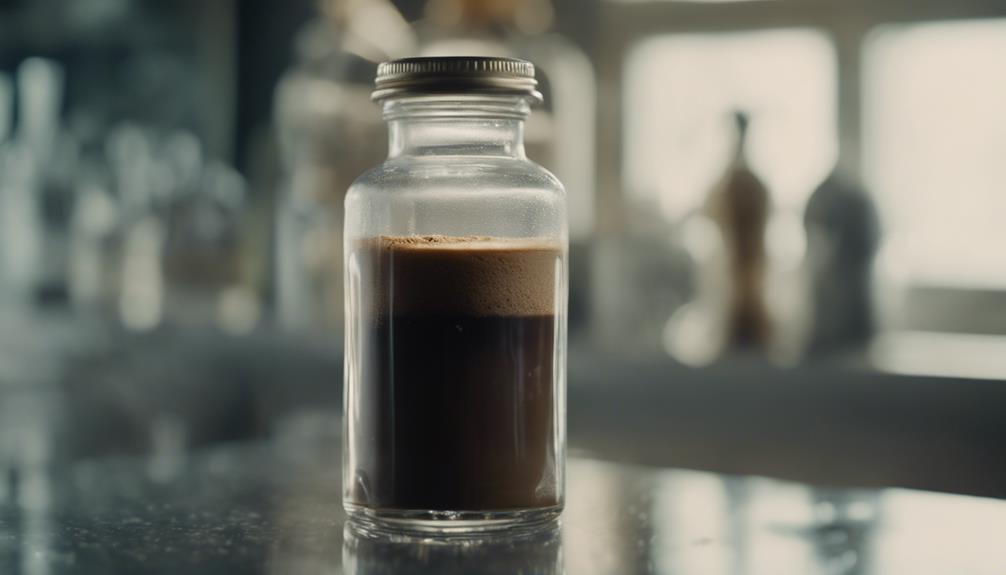
When stored in the fridge, brewed espresso loses freshness within a day due to oxidation and oil breakdown, leading to taste changes. The crema dissipates as a sign of quality decline. An airtight container slightly extends shelf life, with 4-7 days of viability. Store in the coldest fridge section sans milk or sweeteners. Glass containers with airtight lids preserve freshness best. Following these guidelines maintains peak taste.
Key Takeaways
- Brewed espresso lasts 1 day in the fridge before losing freshness.
- Storing in airtight containers slightly extends shelf life.
- Cold temperature slows flavor degradation, extending espresso's freshness.
- Milk or sweeteners shorten espresso's shelf life in the fridge.
- Allow espresso to reach room temperature before refrigerating for optimal storage.
Shelf Life of Brewed Espresso
When storing brewed espresso in the fridge, its shelf life typically lasts for about 1 day before losing its freshness and flavor. To guarantee your espresso stays fresh, it's crucial to consume it within this timeframe.
After a day in the fridge, the brewed espresso starts to undergo changes that affect its taste and quality. The oxidation process and breakdown of oils can turn your once delicious espresso into a bitter, sour, and acidic drink. Additionally, you may notice the crema, that delightful frothy layer on top of your espresso, beginning to dissipate, signaling a loss of freshness.
While storing brewed espresso in an airtight container can help slightly extend its shelf life, it's still most desirable to enjoy it within a day of brewing for the best taste experience.
Factors Affecting Espresso Shelf Life
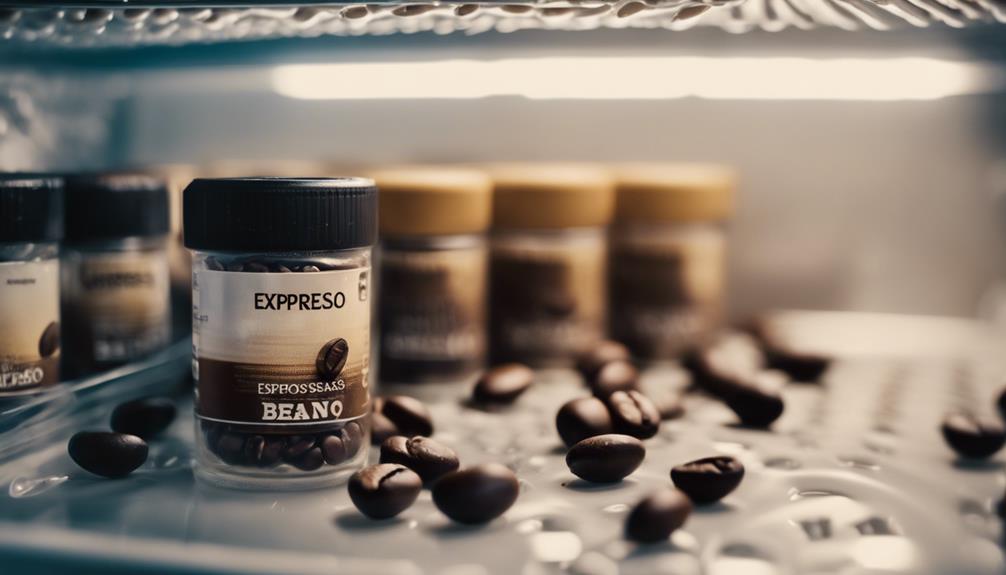
Factors influencing the shelf life of espresso stored in the fridge include the presence of additives like milk or sweeteners, the effectiveness of airtight storage, and temperature control within the refrigerator.
Espresso shots with milk or syrups tend to spoil faster than pure espresso due to the perishable nature of dairy and sugars.
Using an airtight container can help preserve the freshness of espresso by minimizing exposure to oxygen, which can cause flavor degradation.
Additionally, maintaining a consistent temperature in the fridge, ideally in the coldest section, can assist in preserving the quality of stored espresso. Temperature fluctuations can negatively impact the espresso's taste and aroma over time.
Storing Espresso in the Fridge
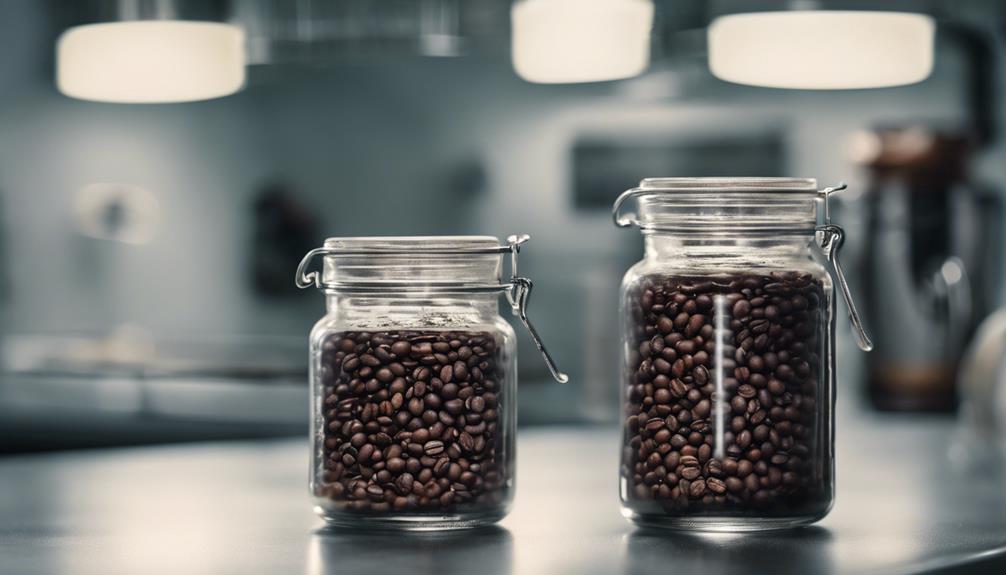
Storing espresso in the fridge demands an airtight container to maintain its freshness. Espresso can last 4-7 days in the fridge if stored properly.
It's imperative to store espresso in the coldest part of the fridge, without milk or sweeteners. Adding sugar can extend its shelf life, but milk or syrups can shorten it due to bacteria growth.
To preserve freshness and flavor, store espresso in a glass container with an airtight lid. Before refrigerating leftover espresso, allow it to reach room temperature to maintain quality.
Proper storage is vital to ensure your espresso lasts in the fridge and retains its taste. By following these guidelines, you can enjoy your espresso for several days without compromising its quality.
Extending Espresso Freshness
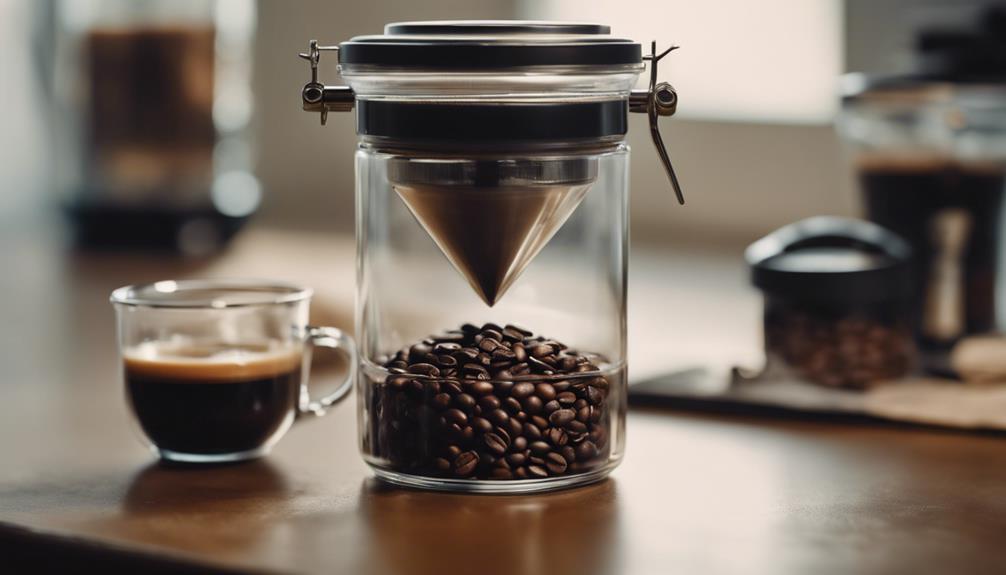
To enhance the longevity of your espresso's freshness, consider storing it in an airtight container in the coldest part of the fridge. By keeping your espresso in an airtight container, you can help protect it from absorbing any unwanted flavors or odors present in the fridge. The cold temperature of the fridge can slow down the degradation of the espresso's flavors, extending its shelf life.
It's important to note that adding milk or sweeteners to your espresso can shorten its shelf life. To maintain the flavor and freshness of your espresso for as long as possible, store it without any additives. Additionally, using your espresso within a few days of brewing and avoiding prolonged storage in the fridge can help preserve its rich taste.
For maximum freshness, opt for glass containers with airtight lids when storing leftover espresso. These containers can provide better protection against external factors that may impact the flavor of your espresso.
Freezing Brewed Espresso
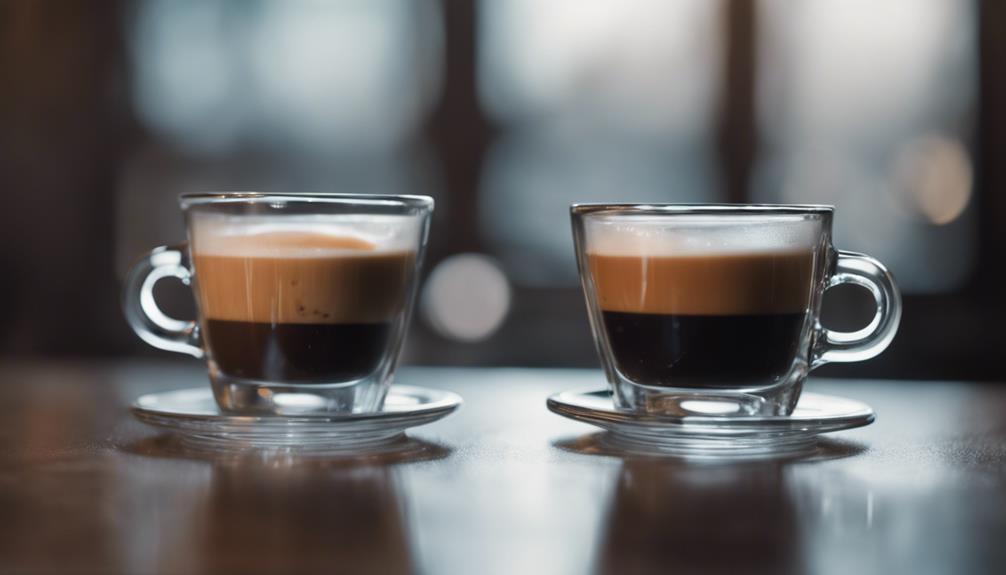
When freezing brewed espresso, it's important to take into account potential changes in taste and texture over time.
The quality of frozen espresso can deteriorate, impacting its overall flavor profile.
To maintain peak taste, it's suggested to consume frozen brewed espresso within a reasonable timeframe.
Freezing Brewed Espresso
If you're looking to extend the shelf life of your brewed espresso, freezing it can be a viable option. By freezing brewed espresso, you can prolong its longevity beyond just a few days in the fridge.
However, there are important factors to take into account:
- Longevity: Brewed espresso can last several months in the freezer, allowing you to enjoy it over an extended period.
- Flavor and Texture: Freezing brewed espresso may lead to flavor distortion and texture changes, affecting the overall quality of the drink.
- Quality Degradation: Over time, the quality of the brewed espresso stored in the freezer may degrade, impacting its taste.
- Portioning Convenience: Consider freezing brewed espresso in ice cube trays to create convenient portions for future use.
Ice Cube Espresso
Freezing brewed espresso in ice cube trays is a practical method to preserve its freshness and flavor for longer durations. By turning your espresso into ice cubes, you can conveniently store them in the freezer and use them whenever needed without compromising on taste.
These espresso ice cubes are perfect for adding a burst of flavor to your iced coffee or other beverages without watering them down. Properly stored espresso cubes can maintain their quality for up to two months, allowing for extended preservation.
The benefit of freezing brewed espresso extends beyond preservation; it also offers portion control and easy access to a quick caffeine fix. When incorporated into drinks, espresso ice cubes can enhance the overall taste experience by infusing a rich coffee flavor.
Espresso in Ice Trays
Transforming brewed espresso into ice cubes is a smart method to prolong its freshness and flavor. Freezing brewed espresso in ice trays can help preserve its freshness, allowing you to enjoy a rich coffee taste whenever you desire.
Here are some key points to keep in mind when using espresso ice cubes:
- Espresso stored in ice cube form is convenient for portioning and use in drinks.
- Frozen espresso cubes can extend the shelf life of brewed espresso for longer enjoyment.
- Using espresso ice cubes in beverages prevents dilution while maintaining a rich coffee flavor.
- Properly stored frozen espresso cubes can be a handy way to have fresh coffee on hand.
Avoiding Espresso Deterioration
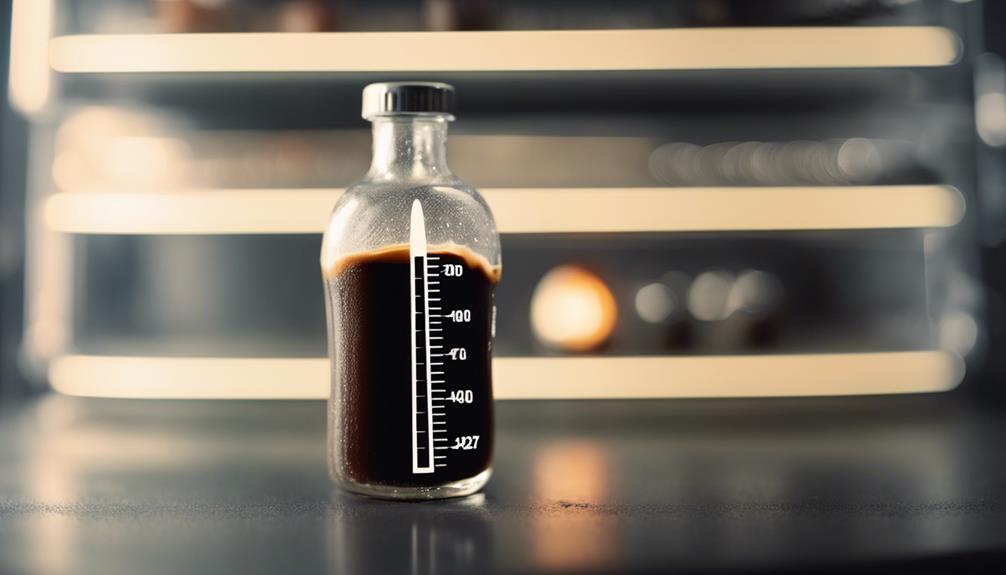
To guarantee espresso from deteriorating, store it in a properly sealed glass container in the fridge.
When you store your brewed espresso drinks in the fridge, you can maximize their shelf life to around 4-7 days. The key to maintaining the rich espresso taste is proper storage. Make sure to seal the container tightly to prevent any exposure to air that could compromise the flavor.
Additionally, avoid leaving your espresso in the fridge for too long as prolonged storage can lead to flavor degradation. For best results, place the airtight container in the coldest part of your fridge to slow down the deterioration process.
Before using refrigerated espresso, always check for any off odors or flavors to make certain that the quality of your drink is preserved. By following these storage tips, you can enjoy fresh-tasting espresso for longer periods.
Utilizing Leftover Espresso
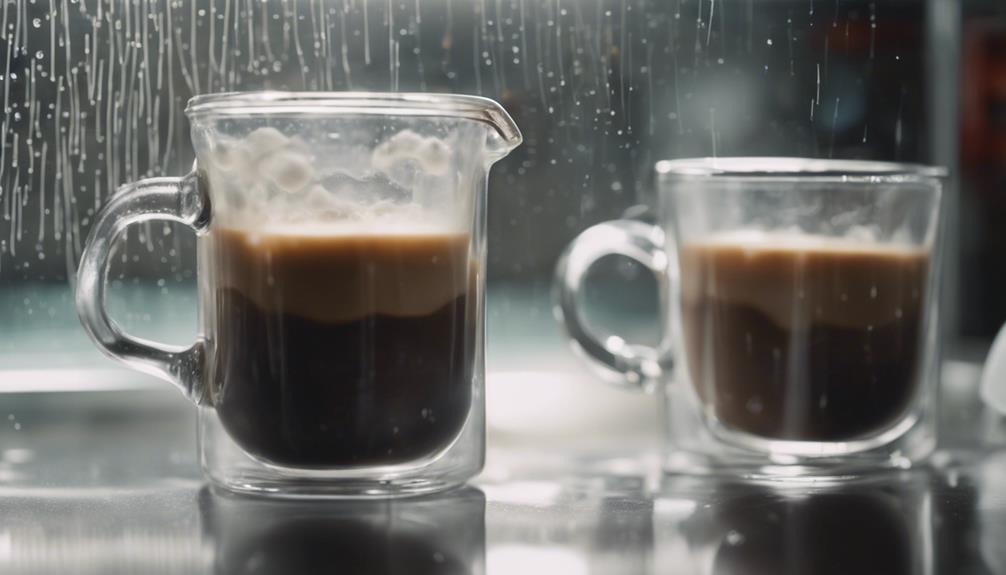
When it comes to utilizing leftover espresso, there are various ways to make the most of it.
From reheating it safely to repurposing it in creative recipes, there's no need to let that extra espresso go to waste.
Storing it properly, being creative with how you use it, and ensuring it doesn't go bad are essential aspects to keep in mind.
Storing Leftover Espresso
Consider cooling your leftover espresso to room temperature before transferring it to a sealed glass container for best freshness. Storing leftover espresso in a glass container with an airtight lid helps maintain its flavor and aroma. Here are some tips for storing leftover espresso:
- Use a glass container: Opt for glass containers over plastic ones to preserve the quality of your espresso.
- Seal it tightly: Make sure the lid is airtight to prevent any air from seeping in and impacting the taste.
- Store in a cool, dark place: Keep the glass container in a cool and dark area to protect the espresso from light and heat.
- Use it creatively: Instead of letting leftover espresso go to waste, repurpose it in various recipes like cocktails, iced beverages, or baked goods.
Following these guidelines will make sure that your leftover espresso stays fresh and can be enjoyed in a variety of ways.
Reheating Espresso Safely
Reheating leftover espresso can alter its taste due to oil separation, potentially resulting in a bitter flavor profile. When espresso is reheated, the oils in the coffee can separate, leading to a degraded taste. This process can intensify bitterness, affecting the overall flavor of your drink.
To maintain the original taste of your brewed espresso, it isn't advised to reheat it once it has been brewed. If you're looking to enjoy your leftover espresso without compromising its flavor, consider exploring alternative storage methods that can help preserve its taste.
Repurposing Espresso Creatively
Utilize leftover espresso creatively by incorporating it into various recipes and drinks to enhance their flavor profiles and prevent waste. Repurposing espresso can lead to innovative and delicious outcomes that go beyond the traditional coffee experience.
Here are some creative ways to make the most out of your leftover espresso:
- Espresso Martinis: Mix leftover espresso with vodka, coffee liqueur, and a touch of sugar for a sophisticated cocktail.
- Iced Lattes: Pour chilled espresso over milk and ice for a revitalizing pick-me-up on warm days.
- Espresso-Infused Chocolate Cakes: Add espresso to your chocolate cake batter for a rich and decadent dessert.
- Frozen Espresso Cubes: Freeze espresso into ice cubes to use in future coffee or smoothie recipes without diluting the flavor.
Repurposing espresso not only prevents wastage but also adds a depth of flavor to your culinary creations. Try these ideas to elevate your dishes and beverages with a hint of espresso goodness.
Maximizing Espresso Beans' Lifespan
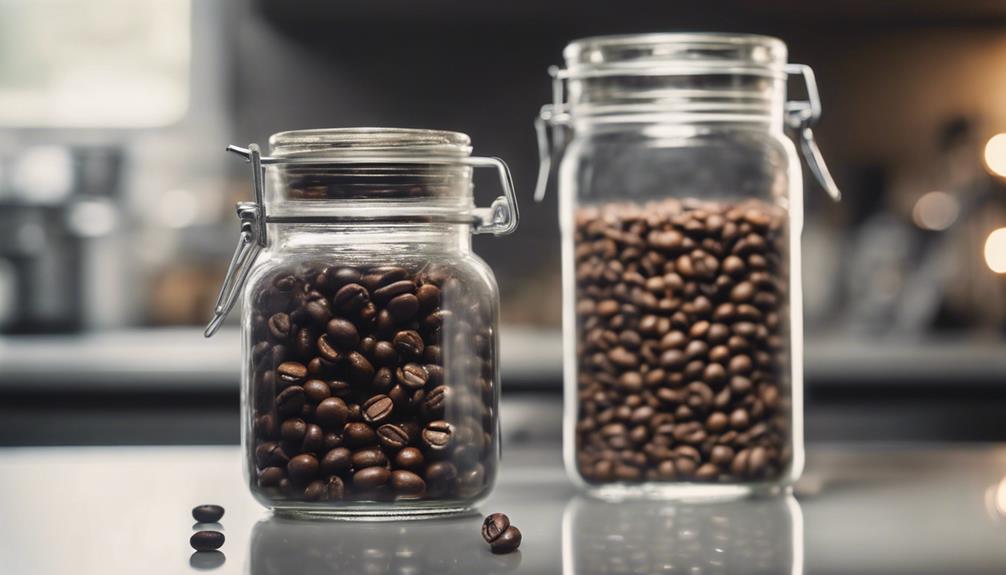
To maximize the lifespan of your espresso beans, make sure they're stored in airtight containers at room temperature or in the fridge for extended freshness. Espresso beans can last up to a year when unopened. However, once you crack open that seal, it's best to use them within 1 week to 1 month for the most delicious brew.
When it comes to ground espresso beans, aim to brew them within a few days of grinding to savor their full flavor profile. Proper storage conditions play an essential role in extending the shelf life of espresso beans, so keep them in airtight containers at room temperature or chill them in the fridge if you want to preserve their freshness.
As for brewed espresso, it typically retains its quality for about a day in the fridge before losing its rich taste and aroma. Remember, if you have any leftover espresso, transfer it to a glass container with an airtight lid to maintain its quality and shield it from absorbing other odors in the fridge.
Frequently Asked Questions
How Long Will Espresso Keep in the Fridge?
Espresso stored in the fridge can last a few days to a week, but the flavor may deteriorate over time. Factors like the drink type, container, and additives can impact shelf life.
Adding milk or sweeteners shortens freshness. For best results, store espresso in an airtight glass container in the coldest fridge section.
Enjoy within a few days to avoid spoilage when milk or sweeteners are included.
How Do You Know if Espresso Is Bad?
To determine if espresso is bad, look for changes in flavor, loss of crema, and a sour or bitter taste. Spoiled espresso can have a rancid smell and should be discarded if it has been in the fridge for over a week.
Mold growth, unusual colors, or a slimy texture are signs that espresso has gone bad. Trust your senses to know when your espresso is past its prime and not safe to drink.
Does Espresso Actually Expire?
Espresso doesn't have a set expiration date but its quality can deteriorate over time. Factors like additives, milk, or sweeteners can impact how long it stays fresh.
To maximize shelf life, store espresso in an airtight container in the fridge's coldest section. Without milk or sweeteners, espresso can last longer.
Monitor its taste and aroma to determine if it's still good to drink.
Does Coffee Go Bad in the Fridge?
Coffee stored in the fridge can degrade in quality due to moisture absorption, potential mold growth, and odor absorption from other food items. The porous nature of coffee makes it susceptible to picking up fridge odors, impacting its freshness.
To maintain peak flavor, store coffee in a cool, dry, and dark place. Airtight containers are best for fridge storage to preserve coffee's aroma and taste.
Can I Store Espresso Powder in the Fridge to Extend its Shelf Life?
Yes, you can store espresso powder in the fridge to extend its shelf life, but it’s not necessary. The proper way to store it is in an airtight container in a cool, dark place. Just make sure to check the espresso powder expiration date to ensure its freshness.
Can Storing Espresso in the Fridge Impact its Shelf Life?
Storing espresso in the fridge can affect its freshness and flavor. According to the espresso freshness guide, exposing it to moisture and odors in the fridge can compromise its quality. It’s best to store it in an airtight container in a cool, dark place to preserve its shelf life.
Conclusion
To sum up, storing brewed espresso in the fridge can extend its lifespan, but it may affect the flavor and quality over time.
To maximize freshness, consider freezing small portions or utilizing leftovers in creative ways.
Remember, when it comes to espresso, freshness is key, so don't cry over spilled milk – keep those beans tightly sealed and brew a fresh cup whenever possible.
Espresso
What Is Espresso? Uncover the Secrets Behind This Bold Brew!
Behind the rich flavors and aromas of espresso lies a world of history, technique, and precision – discover its secrets.

You're about to discover the rich world of espresso, where a perfect blend of coffee beans, precise brewing techniques, and a dash of history come together to create a bold and complex brew. Espresso originated in 19th-century Italy, where innovators like Angelo Moriodo and Luigi Bezzera pioneered steam-driven coffee machines. To craft the perfect shot, you'll need high-quality beans, a balanced roast profile, and a fine grind size. With the right techniques and equipment, you can reveal the secrets of espresso and experience the vibrant flavors and aromas that make it a beloved morning ritual – and that's just the beginning.
Key Takeaways
- Espresso originated in 19th-century Italy, driven by increased coffee demand and the need for faster preparation.
- High-quality coffee beans, freshly roasted, yield rich flavor and aroma, with balanced roast profiles avoiding overly intense light roasts.
- The perfect brewing process involves optimal machine condition, fine grind size, consistent pressure, and peak extraction time of 25-30 seconds.
- Espresso brewing techniques require even tamping, ideal grind size, and proper extraction times for balanced flavor and improved extraction.
Origins of Espresso
When you explore the rich history of espresso, you'll find that it originated in 19th-century Italy as a response to the growing coffee demand and the need for faster coffee preparation in cafes. As coffee became an integral part of Italian culture, the need for a quicker brewing method became apparent.
Angelo Moriodo's invention of the first steam-driven coffee machine in 1884 marked the beginning of espresso's evolution. Luigi Bezzera improved upon Moriodo's design, using steam pressure to brew coffee, which laid the groundwork for modern espresso machines.
The term 'espresso' is derived from the Italian verb 'esprimere,' meaning 'to press out,' reflecting the method of extracting coffee rather than the speed of preparation. You might think that 'espresso' refers to the speed at which coffee is made, but it's actually about the process of forcing pressurized hot water through finely ground coffee.
Understanding the origins of espresso and its early innovators, like Moriodo and Bezzera, helps you appreciate the complexity of brewing coffee and the significance of Italy in shaping the world's coffee culture.
Delving into espresso's history can also help you refine your coffee palate and appreciation for the perfect cup.
The Perfect Brewing Process
To master the art of brewing espresso, you'll need to focus on several key elements that work together to create the perfect shot.
First, verify your espresso machine is in top condition, as it's the foundation of the brewing process.
Next, pay attention to the grind size of your coffee beans – a fine grind, similar to table salt, is ideal for even extraction and peak flavor.
When loading the portafilter, use 18-20 grams of coffee grounds for a single shot, which will result in a rich and concentrated brew.
Tamp the grounds with consistent pressure to promote balanced extraction and flavor.
Now, it's time to brew. The peak extraction time is between 25-30 seconds – too fast and the flavors will be weak, too slow and the shot will be bitter.
As you perfect the brewing process, you'll reveal the rich flavors that espresso has to offer.
With practice, you'll be able to coax out the unique characteristics of each coffee bean, creating a truly exceptional shot.
Ideal Coffee Bean Selection
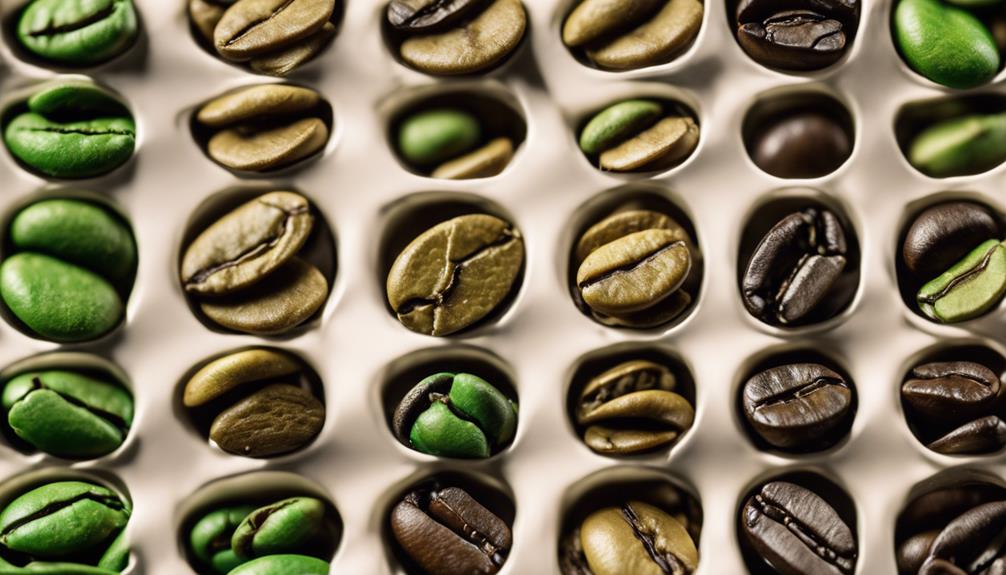
Selecting the right coffee beans is crucial for crafting exceptional espresso, and you'll want to focus on high-quality, freshly roasted beans that offer unique flavor profiles. When choosing beans, consider the roast profile and flavor profile you prefer. Here's a breakdown of key considerations:
| Bean Characteristics | Impact on Espresso |
|---|---|
| High-quality beans | Rich, vibrant flavor and aroma |
| Freshly roasted beans | Ideal flavor and aroma, with notes of fruit and chocolate |
| Balanced roast profile | Avoids overly intense light roasts, yielding a smooth, full-bodied espresso |
When selecting beans, you'll want to avoid those that are too light or too dark. Instead, opt for beans with a balanced roast profile that will yield a smooth, full-bodied espresso. High-quality beans are crucial for ideal flavor, and freshly roasted beans will guarantee the best possible taste. By choosing the right beans, you'll be well on your way to crafting exceptional espresso. Remember, the quality of the beans greatly influences espresso craftsmanship, so don't be afraid to experiment with different roast profiles and flavor profiles to find your perfect cup.
Espresso Roast Profile Explained
Now that you've selected the perfect coffee beans, it's time to explore the art of espresso roast profiles.
You'll want to understand the characteristics of espresso roasts, which are typically darker and roasted longer to bring out rich and bold flavors.
Espresso Roast Characteristics
When it comes to crafting the perfect espresso shot, understanding the nuances of espresso roast characteristics is key, as the roast profile plays a significant role in bringing out the desired flavors and aromas in your cup.
As you experiment with different espresso roast profiles, you'll discover that they often showcase a deeper, more caramelized flavor profile, thanks to the extended roasting time. However, keep in mind that achieving the perfect balance requires selecting the right type of coffee beans and fine-tuning your roast levels.
It's widely recognized that certain espresso beans – like lighter roasts – can yield overly intense flavors when brewed as espresso, resulting in a cup that's unbalanced and possibly bitter. Conversely, combining different coffee bean origins in the perfect proportion creates the magic blend you want.
That balance directly hinges on both beans you have to craft to effectively keep pace or resonate sound frequency. Yet, combining sound process procedures and putting the correct quantity can yield outstanding pure notes. This set blending produces the peak experience in your espresso.
Flavor Profile Balance
You're likely familiar with the concept that achieving a perfect balance in flavor profiles is vital for a great espresso experience, as it hinges on the delicate interplay between sweetness, acidity, and bitterness.
When it comes to espresso roast profiles, finding this balance is vital. Lighter roasts can be too intense if not roasted carefully, while darker roasts may become bitter if over-roasted. Adjusting roasting times and temperatures helps achieve the desired flavor balance, allowing for variations that cater to personal taste preferences.
To create a balanced espresso, roasters often blend different coffee grounds, including robusta beans, to enhance the caffeine content and introduce a fuller body. The ideal espresso roast profile should result in a harmonious combination of sweetness, acidity, and bitterness.
The presence of crema is a key indicator of the espresso's quality and flavor balance. By understanding how to balance flavor profiles, you'll be able to appreciate the nuances of different espresso roast profiles and find the perfect blend to suit your taste.
Whether you prefer a brighter, more acidic flavor or a richer, more robust taste, achieving flavor balance is vital for a great espresso experience.
Brewing Techniques and Tips
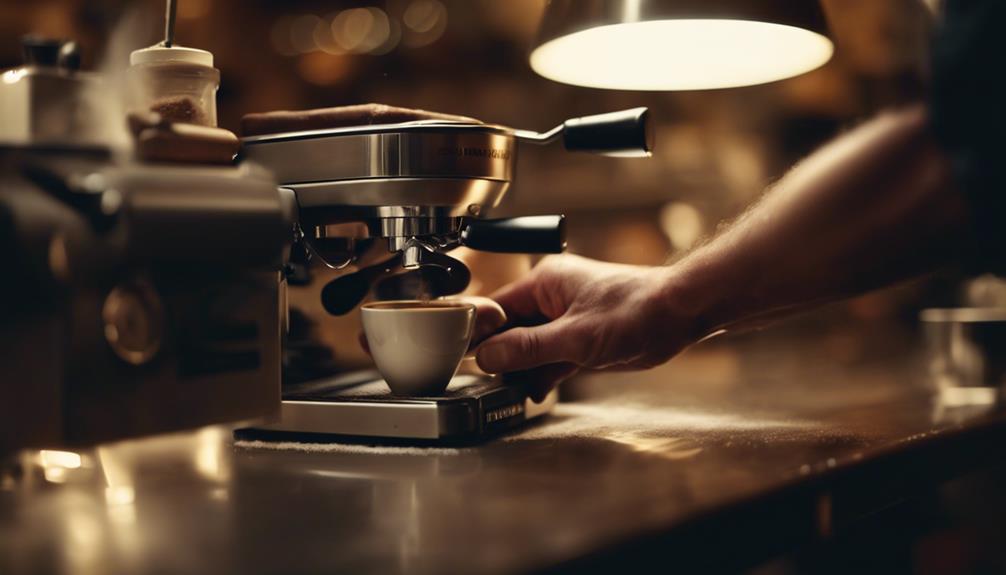
As you explore the world of espresso brewing, you'll quickly realize that perfecting the grind size is essential for achieving that perfect shot.
Mastering the grind size requires attention to detail and a bit of experimentation to find the ideal consistency.
Perfecting the Grind Size
To perfect the grind size for espresso, it's crucial to aim for a fine grind, similar to table salt, which is necessary for ideal extraction and rich flavor.
As you work to master the grind size, consider these key factors to optimize your brewing experience:
- Uniformity is key, and a burr grinder can help achieve the consistency needed for even extraction.
- A fine grind can enhance extraction but can also lead to bitterness if over-extracted.
- For a single shot of espresso, the ideal dose is between 18-20 grams of ground coffee, making precise measurements in grinding essential.
- Experimenting with different grind sizes affects the flavor profile; adjusting this is part of fine-tuning the espresso shot.
Keep these aspects in mind, and remember, fine-tuning your grind size with each use can guarantee your ground coffee complements your burr grinder for an unparalleled shot of espresso every time.
With consistent experimentation, you can enjoy that bold flavor everyone wants to know more about – every shot will deliver perfect and engaging outcomes in mastering that strong blend in brew form!
Mastering Brewing Techniques
Mastering brewing techniques is crucial for releasing the full flavor potential of your espresso, and it starts with understanding the importance of even tamping and precise water temperature control. When you tamp the coffee grounds evenly, you guarantee a balanced flavor profile and improved extraction quality. Additionally, monitoring the water temperature between 195-205°F during brewing is imperative, as this range greatly impacts the final taste of the espresso.
To achieve the perfect coffee, consider the following brewing techniques:
| Brewing Method | Water Temperature | Coffee-to-Water Ratio |
|---|---|---|
| Espresso | 195-205°F | 1:2 |
| Pour-over | 200-210°F | 1:15 |
| French press | 195-205°F | 1:12 |
When brewing espresso, use 18-20 grams of coffee grounds in the portafilter and aim for an extraction time of 25-30 seconds. This will prevent weak flavors from fast extractions or bitterness from slow extractions. By mastering these brewing techniques, you'll be able to bring out the unique flavors of your favorite beans and enjoy a perfect cup of coffee every time. With practice and patience, you'll become a skilled barista, capable of crafting exceptional espresso shots that impress even the most discerning coffee connoisseurs.
Fun Facts and Trivia
Discovering the lesser-known facts behind your favorite morning shot of espresso reveals a complex beverage that's full of surprising details, ranging from its etymology to brewing methods and misconceptions surrounding it.
As you sip on your espresso, you might be wondering what makes it so unique. Let's explore some fun facts and trivia that'll make you appreciate your daily cup even more.
Here are a few interesting tidbits about espresso:
- Espresso doesn't actually mean 'express' in Italian, but rather 'to press out' from the verb 'esprimere'.
- You might think espresso has more caffeine than filter coffee, but a standard serving of espresso actually contains less caffeine overall.
- Italian regulations require specific criteria for a shot of espresso to be considered true espresso, including minimum brewing pressure and extraction time.
- Historically, espresso blends often included robusta beans to increase caffeine content and enhance crema.
These facts show that there's more to espresso than just its bold flavors and rich aromas.
Whether you're a coffee connoisseur or just a casual fan, understanding the intricacies of espresso can enhance your appreciation for this beloved beverage.
Frequently Asked Questions
What Scientists Claim to Have Discovered the Secret to Perfect Espresso?
You're about to uncover the secret to perfect espresso! Scientists claim to have discovered that adding water before grinding coffee beans enhances consistency and taste, reducing static electricity and waste, and leading to stronger flavor extraction.
What Is Bold Espresso?
"Variety is the spice of life," and when it comes to bold espresso, you're in for a treat. You're brewing a concentrated coffee by forcing hot water through finely ground beans, resulting in a rich, strong flavor.
How Is Espresso Different From Coffee?
You're probably wondering how espresso differs from regular coffee. The main differences lie in brewing pressure, grind size, extraction time, and serving size, resulting in a richer, more intense flavor and a unique crema layer in espresso.
What Is the Difference Between Bold and Strong Coffee?
You might've noticed how some friends order "bold" coffee, while others ask for "strong" coffee. What's the difference? Think of it like music – bold coffee is like a rich, complex symphony, while strong coffee is more like a loud, intense beat.
Conclusion
As you wrap up your espresso journey, it's no coincidence that you've discovered the perfect blend of art and science.
The rich flavors and bold aromas have likely left you wondering how something so small can pack such a punch.
It's a coincidence that the same passion and dedication that goes into crafting each shot is the same passion that drives you to savor every last drop.
Espresso
How to Make the Perfect Espresso Martini – Step-by-Step Guide!
Learn the art of crafting the ultimate Espresso Martini with our expert guide, but be warned: once you taste perfection, there's no turning back.

To make the perfect Espresso Martini, you'll need 50ml of vodka, 35ml of coffee liqueur, and 25ml of freshly brewed espresso. Start by brewing a strong shot of espresso and letting it cool. Fill a cocktail shaker with ice, add the vodka, coffee liqueur, and a splash of simple syrup, and shake vigorously for 15 seconds. Double strain the mixture into a chilled martini glass and garnish with three coffee beans. With these basics down, you're ready to take your Espresso Martini to the next level – and with a few tweaks, you can make it truly unforgettable.
Key Takeaways
- Brew a strong shot of espresso and let it cool to maintain flavor in the martini.
- Fill a cocktail shaker with ice, adding vodka, coffee liqueur, and simple syrup for a balanced mix.
- Shake the mixture vigorously for 15 seconds to create a rich, frothy texture in the martini.
- Double strain the mixture into a chilled martini glass using a cocktail strainer and fine mesh sieve.
Ingredients and Equipment Needed
To craft the perfect Espresso Martini, you'll need to gather a few essential ingredients and pieces of equipment, starting with a trifecta of vodka, coffee liqueur, and freshly brewed espresso.
The vodka should be 50ml, while the coffee liqueur should be 35ml – Kahlúa is a popular choice. The espresso, which is the star of the show, should be 25ml and freshly brewed.
In terms of equipment, you'll need a cocktail shaker to mix everything together. A jigger will also come in handy for accurate measurement of the ingredients.
Additionally, a fine mesh sieve or cocktail strainer is necessary for a smooth pour into the martini glass. Don't forget the ice – you'll need fresh cubes to chill the cocktail without diluting it.
A pre-chilled martini glass is also a must, so make sure to fill it with ice before pouring in the Espresso Martini.
With these ingredients and equipment at your disposal, you'll be well on your way to creating the perfect Espresso Martini.
Step-by-Step Preparation Guide
With your ingredients and equipment at the ready, it's time to start crafting the perfect Espresso Martini by following a simple, step-by-step preparation guide.
Begin by brewing a strong shot of espresso and letting it cool to prevent dilution when mixed with ice.
Next, fill a cocktail shaker with ice, then add 1 1/2 oz. vodka, 1 oz. coffee liqueur (like Kahlúa), and 1/2 oz. simple syrup to balance the flavors.
Shake the mixture vigorously for about 15 seconds to create a frothy texture and guarantee everything is well combined. This step is essential in bringing out the rich flavors of the espresso and coffee liqueur.
After shaking, double strain the mixture into a chilled martini glass to achieve a smooth pour and eliminate any ice shards.
Finally, garnish with three coffee beans to symbolize health, wealth, and happiness, and serve immediately for the best experience.
Expert Tips for Success
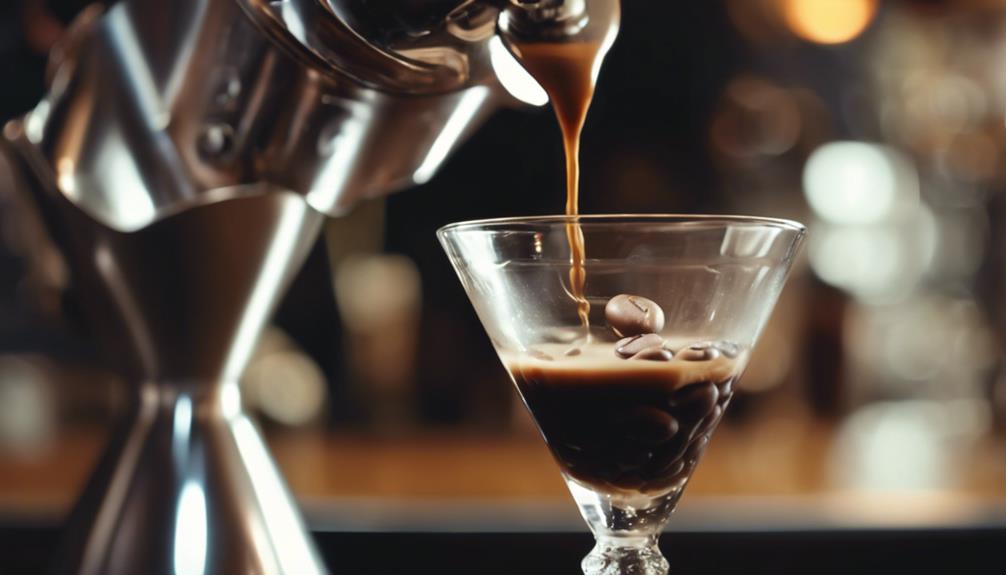
Mastering the art of crafting the perfect Espresso Martini requires attention to detail and a few expert tips to elevate your mixology skills.
To start, verify your espresso is freshly brewed and cooled to prevent dilution when mixed with ice in the cocktail shaker. This simple step will make a significant difference in the overall flavor and texture of your Espresso Martini.
When shaking the mixture, don't be shy – vigorously shake the cocktail shaker for at least 15 seconds to create a rich, frothy texture that enhances the drink's presentation and mouthfeel.
To achieve a smooth pour without ice shards, use a cocktail strainer along with a fine mesh sieve to double strain the mixture.
Experiment with different coffee liqueurs, such as Tia Maria or newer brands, to discover unique flavor profiles that suit your taste preferences.
Finally, adjust the amount of simple syrup to balance the bitterness of the espresso with the sweetness of the liqueur.
By following these expert tips, you'll be well on your way to crafting a perfect Espresso Martini that will impress even the most discerning palates.
With practice, you'll refine your skills and create a truly exceptional cocktail.
Understanding the Espresso Martini
You're about to explore the world of the Espresso Martini, a cocktail that's equal parts energizing and indulgent, and has been a staple of nightlife for decades. This classic drink has gained a massive following among coffee lovers and cocktail enthusiasts alike.
The Espresso Martini's unique blend of vodka, coffee liqueur, and freshly brewed espresso creates a flavor profile that's both rich and indulgent. The drink's origins date back to the 1980s, when British bartender Dick Bradsell created it in response to a request for a drink that would both awaken and intoxicate the drinker.
Traditionally garnished with three coffee beans, each bean symbolizes health, wealth, and happiness in Italian culture. The Espresso Martini's popularity soared in London's nightlife and has seen a resurgence in recent years. Its balance of bitter espresso and sweet coffee liqueur makes it a perfect choice for after dinner or special occasions.
As you explore into the world of the Espresso Martini, you'll discover why it's a timeless classic that continues to captivate palates around the world. With its unique flavor profile and energizing kick, it's no wonder the Espresso Martini remains a favorite among coffee lovers and cocktail enthusiasts.
Common Variations and Substitutions
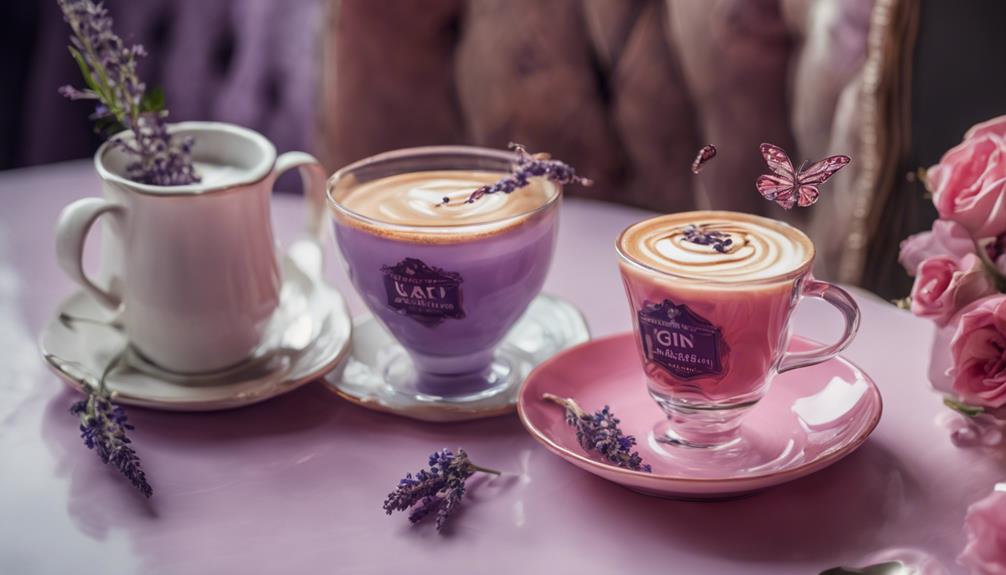
When it comes to perfecting the Espresso Martini, the door is wide open to creativity through substitutions and variations, allowing you to customize this iconic cocktail to suit your personal taste.
If you don't have an espresso machine, you can try using cold brew concentrate as a substitute for espresso, which provides a similar coffee flavor without the need for brewing.
In addition to espresso substitutes, you can also experiment with coffee liqueur alternatives to Kahlúa. Try using Tia Maria or a newer brand to offer a unique flavor profile to your martini.
If you're looking to make sweetness adjustments, you can modify or omit the simple syrup altogether. If you prefer a less sweet drink, consider reducing the amount or using flavored syrups like vanilla or hazelnut.
Serving Suggestions and Pairings
What makes the Espresso Martini truly shine is its versatility in pairing with a variety of sweet and savory treats, allowing you to elevate your entertaining game with ease. When it comes to pairings, you can't go wrong with rich desserts like chocolate mousse or tiramisu, which complement the drink's coffee notes perfectly. But that's not all – the Espresso Martini also makes a delightful after-dinner drink, helping to alleviate post-meal lethargy with its caffeine content.
| Occasion | Pairing Suggestions | Why it Works |
|---|---|---|
| Dinner Party | Dark chocolate or gourmet coffee-flavored treats | Elevates the tasting experience with sophisticated flavors |
| Birthday or New Year's Eve | Light appetizers like cheese platters or charcuterie boards | Balances savory and sweet elements for a festive atmosphere |
| After Dinner | Rich desserts like chocolate mousse or tiramisu | Complements the drink's coffee notes and alleviates post-meal lethargy |
| Casual Gathering | Coffee-flavored cookies or brownies | Enhances the drink's rich coffee flavor and adds a playful touch |
Frequently Asked Questions
What Are the Ingredients of an Espresso Martini?
You're looking for the ingredients of an Espresso Martini! Typically, you'll need 50ml of vodka, 35ml of coffee liqueur, and 1 shot of freshly brewed espresso, with optional simple syrup and Baileys for added flavor.
What Is the 3 Bean Rule for Espresso Martini?
You're about to discover the 3 bean rule, a traditional garnish for Espresso Martinis, symbolizing health, wealth, and happiness. This iconic presentation involves three coffee beans, typically arranged in a triangle pattern, on top of your drink.
What Are the Standards in an Espresso Martini?
"As you begin crafting an espresso martini, recall: "don't just aim to get close to perfect; instead aim beyond the possibility of 'very close.' Shoot to ace every corner on one precision push.'" Then define the actual definition without content contained context current webaddress–
What Liquor Is Best for an Espresso Martini?
When crafting an Espresso Martini, you'll want to choose a high-quality vodka that's smooth and flavorful. Opt for brands like Grey Goose or Belvedere, which won't overpower the other ingredients and will complement the coffee flavors nicely.
Conclusion
Now that you've mastered the art of crafting the perfect espresso martini, it's time to shake (not stir) things up!
With every sip, the rich flavors will transport you to a vibrant Italian night, where the air is electric and the music is pulsating.
Your taste buds will do the tango with the bold espresso, velvety vodka, and sweet coffee liqueur.
Cheers to a drink that's sure to perk up any gathering!
Espresso
Shaken Espressos: Do They Get Half Pumps?
Explore if your shaken espressos require fewer pumps of syrup for the perfect balance of flavor in each sip. Learn the barista secrets now.

When you order a shaken espresso at Starbucks, have you ever wondered about the secret behind its perfectly balanced flavor? It turns out that these tantalizing beverages receive a unique treatment when it comes to the amount of syrup used. Contrary to popular belief, shaken espressos get half pumps of syrup instead of the standard full pumps. But why? And how does this impact the overall taste experience?
For years, this insider knowledge was kept hidden from new baristas during their training. It wasn’t until the introduction of the new Hazelnut Shaken Espresso that the revelation was finally made. The question then arose: Should a syrup with a half pump be doubled to equal one full pump? Is it possible to achieve that perfect balance of flavors with only half the usual amount of syrup?
In this article, we will delve into the secrets of Starbucks baristas and explore the practice of using half pumps in shaken espressos. By uncovering the rationale behind this technique, we will discover how it contributes to the exceptional taste and quality of these popular beverages.
So, get ready to embark on a journey into the realm of barista secrets and unlock the mystery behind the exquisite flavor profiles of your favorite shaken espressos!
Key Takeaways:
- Shaken espressos at Starbucks receive half pumps of syrup instead of full pumps, contrary to popular belief.
- This information was initially withheld from new baristas during their training, only being revealed with the introduction of the Hazelnut Shaken Espresso.
- Exploring the use of half pumps ensures a perfect balance of flavors in each sip of a shaken espresso.
- Understanding the secrets behind barista techniques can enhance the enjoyment of your favorite Starbucks beverages.
- Stay tuned as we uncover more secrets and explore the intricate world of Starbucks flavor profiles.
The Shelf Life of Syrups and Sauces
Starbucks places high importance on maintaining the quality and freshness of its products, including the syrups and sauces used in their beverages. Understanding the shelf life of these components is crucial for baristas to ensure that every drink served meets the company’s standards.
In general, the shelf life of syrups and sauces at Starbucks is approximately 30 days. This applies to various essential ingredients like frappuccino syrup bases and mocha sauce. However, it’s important to note that not all syrups and sauces have the same shelf life duration.
For example, caramel sauce, which is commonly used as a topping, has a slightly shorter shelf life of 14 days. This is due to the nature of caramel and its potential for changes in texture and flavor over time.
The Importance of Adhering to Shelf Life Guidelines
Adhering to the recommended shelf life guidelines is crucial for maintaining the flavors and consistencies that Starbucks customers expect. Using syrups or sauces past their expiration dates can result in altered taste profiles and potentially compromise the overall beverage experience.
Baristas play a vital role in managing inventory and ensuring that syrups and sauces are used within their designated timeframes. This requires regular monitoring, proper labeling, and attention to detail in the beverage preparation process.
Impact on Beverage Quality
The freshness and quality of syrups and sauces directly contribute to the overall taste of Starbucks beverages. By adhering to the specified shelf life guidelines, baristas can ensure that the flavors remain consistent and vibrant throughout each drink.
Additionally, using expired syrups or sauces can lead to unintended flavor combinations or an unpleasant taste that deviates from the intended recipe. This consistency of flavors across all Starbucks locations is a critical aspect of the brand’s reputation.
Shelf Life of Syrups and Sauces
| Syrup/Sauce | Shelf Life |
|---|---|
| Frappuccino syrup bases | Approximately 30 days |
| Mocha sauce | Approximately 30 days |
| Caramel sauce (topping) | Approximately 14 days |
Understanding the shelf life of syrups and sauces is essential for baristas to uphold Starbucks’ commitment to quality and customer satisfaction. By adhering to the recommended guidelines, baristas ensure that each drink is crafted with fresh and flavorful ingredients. Now that you know the importance of shelf life, let’s explore the standard builds for shaken iced teas and shaken espressos in Section 3.
Standard Builds for Shaken Iced Teas and Shaken Espressos
The standard builds for shaken iced teas and shaken espressos at Starbucks ensure that the beverages are consistently prepared according to specific instructions. Each step is carefully followed to achieve the perfect balance of flavors that customers expect.
When it comes to shaken espressos, baristas utilize a unique technique that involves using half dose pumps of syrup. This precise measurement ensures that the espresso shot is not overwhelmed with sweetness, allowing the rich flavors of the espresso beans to shine through.
Similarly, shaken iced teas are meticulously crafted following specific guidelines. The tea concentrate, water, and syrup are combined in precise proportions to create a refreshing and well-balanced beverage.
By adhering to the standard builds for both shaken iced teas and shaken espressos, baristas guarantee that customers receive consistent and delightful experiences with every sip.
Mastering the Art of Shaken Beverages
The art of preparing shaken beverages at Starbucks involves precise measurements and techniques to achieve the desired flavors. Baristas are trained to follow the standard builds closely, ensuring that each drink is crafted to perfection.
“Following the standard builds is crucial in creating the ideal shaken espresso. It’s a delicate balance that enhances the natural flavors of the espresso without overpowering it with sweetness. Our customers appreciate the precision and consistency in every sip. It’s what sets our shaken drinks apart.” – Amy Barnes, Starbucks Barista
Whether it’s an energizing shaken iced tea or a bold shaken espresso, customers can trust that their beverage is made with care and adheres to the established standard builds.
Customizing Drinks for Less Sweetness
While baristas can easily customize the sweetness of lattes and shaken espressos, other drinks at Starbucks, such as chai lattes, smoothies, and Refreshers, are made with pre-sweetened concentrates. This makes it challenging to adjust the sweetness level. However, customers can opt for Refreshers that use water instead of lemonade to reduce sweetness. It is also important to note that removing syrups from Frappuccinos can affect their texture, resulting in a icier consistency. However, ordering coffee or espresso Frappuccinos with less syrup can help achieve a less sweet flavor.
To summarize, here are some ways to customize your Starbucks drinks for less sweetness:
- Choose Refreshers with water instead of lemonade.
- Opt for coffee or espresso Frappuccinos with less syrup.
By making these adjustments, you can enjoy a beverage that suits your preferred level of sweetness.
| Beverage | Sweetness Customization Options |
|---|---|
| Lattes and Shaken Espressos | Baristas can adjust the sweetness level based on your preference. |
| Chai Lattes, Smoothies, and Refreshers | These drinks are made with pre-sweetened concentrates, making it difficult to customize the sweetness. |
| Frappuccinos | Removing syrups can affect the texture, but ordering coffee or espresso Frappuccinos with less syrup can help achieve a less sweet flavor. |
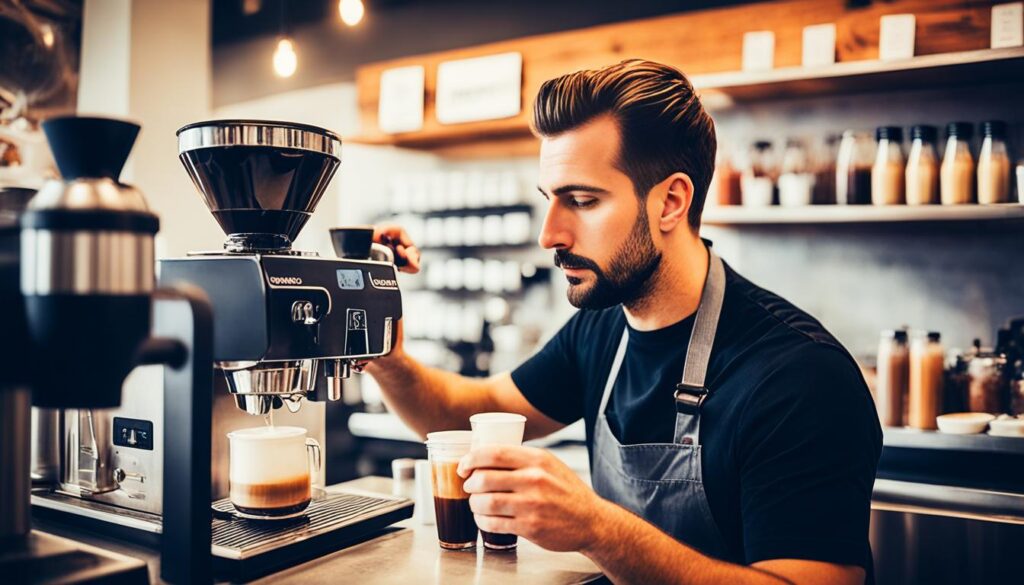
The Sweetness Customization Options at Starbucks
“At Starbucks, we understand that everyone has different preferences when it comes to sweetness. While some drinks can be easily customized for less sweetness, others, like chai lattes and Refreshers, have pre-sweetened concentrates. However, our baristas are trained to make adjustments whenever possible to ensure your drink is just the way you like it.”
Conclusion
In conclusion, shaken espressos at Starbucks indeed receive half pumps of syrup. This knowledge is crucial for baristas to ensure consistent flavors in all beverages. By following the standard builds provided, they can create perfectly balanced drinks for each customer. While customization options may be limited for certain drinks, there are still choices you can make to achieve a less sweet taste.
For those seeking a lighter and less sweet option, consider opting for water-based Refreshers instead of those made with lemonade. Another alternative is ordering coffee or espresso Frappuccinos with less syrup, which can help achieve a more balanced flavor profile.
By understanding the secret techniques and guidelines of Starbucks baristas, you can have a more enjoyable and customized experience at the coffeehouse. Remember to communicate your preferences clearly and explore the available options to find the perfect balance of flavors that suits your taste buds.
FAQ
Do shaken espressos at Starbucks receive half pumps of syrup?
What is the shelf life of syrups and sauces at Starbucks?
What are the standard builds for shaken iced teas and shaken espressos at Starbucks?
Can drinks at Starbucks be customized for less sweetness?
What is the main takeaway from understanding barista secrets?
-

 Coffee Guides2 weeks ago
Coffee Guides2 weeks agoBoost Your Coffee: Easy Ways to Enhance Your Brew
-
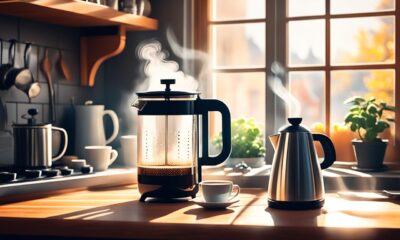
 Coffee Guides2 weeks ago
Coffee Guides2 weeks agoBrew Perfect Coffee at Home: Expert Tips & Tricks
-

 Health and Wellness2 weeks ago
Health and Wellness2 weeks agoHeadache-Free: How to Avoid Coffee Headaches!
-

 Coffee Guides2 weeks ago
Coffee Guides2 weeks agoBecome a Coffee Master: Expert Brewing Tips
-

 Vetted2 weeks ago
Vetted2 weeks ago15 Best Trundle Beds for Maximizing Space and Style in Your Home
-

 Coffee Guides2 weeks ago
Coffee Guides2 weeks agoBreve Coffee Explained: Your Cozy Café Favorite
-

 Coffee Guides2 weeks ago
Coffee Guides2 weeks agoHow to Be a Coffee Cup: Embrace Your Inner Brew
-

 Vetted2 weeks ago
Vetted2 weeks ago15 Best Cordless Pool Vacuums for Effortless Pool Cleaning













